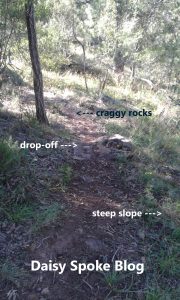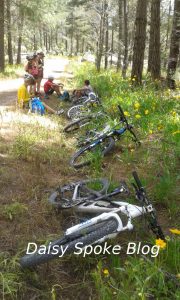When you open your mind to learning and growing, you discover opportunities everywhere around you. Over the past ten years, mountain biking has become a parallel universe for me to learn about myself and the world around me. As my enthusiasm for this style of learning has developed, so too has my love of mountain biking. I wanted to share my excitement with everyone around me and so I began my blog, Daisy Spoke. And my very first post in Daisy Spoke was “5 Things I’ve Learned About Life Through Mountain Biking”.
So ….. now here at last are another five ways that mountain biking has helped me to keep learning and growing as an individual!
1. Look up
 I instinctively look straight down in front of me when I ride my bike. This means I wobble a lot and react to every little lump and bump in the terrain. Having a one way staring competition with the trail right in front of me does me no favours. My imagination fixates on small details that don’t really matter. I didn’t even realise this was happening until I learnt at a coaching session the importance of looking up, to keep my eyes focused further along the track. This gets me into flow and enjoying a smoother, more connected ride. I’m still learning to trust myself, to have confidence that my brain has registered the terrain directly in front of me and that my body will know how to handle it. Every ride is a reminder to keep my sights focused ahead in all areas of my life – my work, my personal life, and my riding!
I instinctively look straight down in front of me when I ride my bike. This means I wobble a lot and react to every little lump and bump in the terrain. Having a one way staring competition with the trail right in front of me does me no favours. My imagination fixates on small details that don’t really matter. I didn’t even realise this was happening until I learnt at a coaching session the importance of looking up, to keep my eyes focused further along the track. This gets me into flow and enjoying a smoother, more connected ride. I’m still learning to trust myself, to have confidence that my brain has registered the terrain directly in front of me and that my body will know how to handle it. Every ride is a reminder to keep my sights focused ahead in all areas of my life – my work, my personal life, and my riding!
2. Absorb the bumps
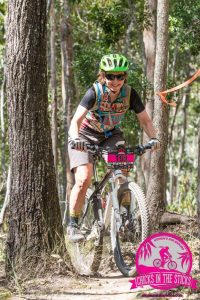
The bumps and jumps are all part of the fun of mountain biking – in fact a very large part of it! But it’s taken me a long time to see it that way. Fear of falling and lack of confidence creates tension which in turn leads to a rigid framework, sore muscles and stiff joints at the end of a ride. Learning to relax my stance and go with the bumps instead of resisting them is an ongoing process. Mountain biking gives me the opportunity to experience a sense of lightness instead of a sense of lack of control. I can visualise my legs as natural built-in shock absorbers. With improved inner resilience, or bounce-ability, I’m also able to relax a bit more in life in general, to see past the hiccups, and rise above the challenges.
3. Move around
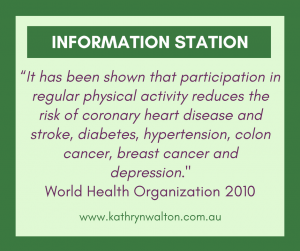 Having ridden mostly on smooth paved surfaces like roads and bicycle paths for most of my life, it’s been a huge learning curve getting onto mountain bike trails. You need to move your weight around constantly adjusting for the ever-changing terrain. Forward and back, side to side, up and down, as well as every possible combination of these movements. The hard lesson is that if you don’t shift your weight around you can’t get up that hill, or down that steep slope, or round that tight corner. Riding can quickly turn into hike-a-bike (which isn’t much fun) or hitting the ground (which also isn’t much fun). So when I ride I try to be conscious of how I move my body – above and around my bike frame. As in life, the more you move around, the more fun you’ll have and the healthier you’ll be.
Having ridden mostly on smooth paved surfaces like roads and bicycle paths for most of my life, it’s been a huge learning curve getting onto mountain bike trails. You need to move your weight around constantly adjusting for the ever-changing terrain. Forward and back, side to side, up and down, as well as every possible combination of these movements. The hard lesson is that if you don’t shift your weight around you can’t get up that hill, or down that steep slope, or round that tight corner. Riding can quickly turn into hike-a-bike (which isn’t much fun) or hitting the ground (which also isn’t much fun). So when I ride I try to be conscious of how I move my body – above and around my bike frame. As in life, the more you move around, the more fun you’ll have and the healthier you’ll be.
4. Be present in the moment

A distracted mind is on a road to mishap. At least, that’s my experience on my mountain bike and life in general. On my bike, the terrain is constantly changing and I need to keep my wits about me at all times. When I tune my sensory antennae into the environment around me, I’m fully present in the here and now. At least that’s the theory! The reality is that sometimes when I’m riding my mind wanders off and suddenly, oops, there it is, a rut the size of the Grand Canyon about to swallow me and my bike. It’s an ongoing learning process of training my brain to come back to the present, Not only does this make me safer on my bike, the ride is heaps more fun too. The same technique applied to other areas of life can lead to more satisfying relationships, more efficient and effective business decisions, and reduced anxiety.
5. Keep trying!
 Throughout life I’ve tended to focus my energy and attention on things that come most easily to me. If I couldn’t do something perfectly the first time, I’d usually move on to the next thing fairly quickly. As far as mountain biking goes, I’d had a few short rides on unpaved paths and paddocks over the years but didn’t develop much interest in “that kind of riding”. I’d fallen off a few times so there wasn’t a lot of incentive to keep going, so my bike tended to stay in the garage most of the time. A few years ago I decided to give it another go. Maybe there was an inner knowing that it would open up a whole new world to me, that there was much more to be gained from riding than simply mountain biking skills. With the support of my Courage Coach, I learned to develop persistence and this has had a profound impact on me. I’ve discovered how valuable persistence can be when life gets tough and I feel like giving up. Persistence speaks to that fiercely determined part of my soul and keeps me trying, practising, modifying, trying again, and finding ways to bring my hopes and dreams into reality. I’ve learned that I can work really hard at things that don’t come naturally to me and to experience immense satisfaction from that!
Throughout life I’ve tended to focus my energy and attention on things that come most easily to me. If I couldn’t do something perfectly the first time, I’d usually move on to the next thing fairly quickly. As far as mountain biking goes, I’d had a few short rides on unpaved paths and paddocks over the years but didn’t develop much interest in “that kind of riding”. I’d fallen off a few times so there wasn’t a lot of incentive to keep going, so my bike tended to stay in the garage most of the time. A few years ago I decided to give it another go. Maybe there was an inner knowing that it would open up a whole new world to me, that there was much more to be gained from riding than simply mountain biking skills. With the support of my Courage Coach, I learned to develop persistence and this has had a profound impact on me. I’ve discovered how valuable persistence can be when life gets tough and I feel like giving up. Persistence speaks to that fiercely determined part of my soul and keeps me trying, practising, modifying, trying again, and finding ways to bring my hopes and dreams into reality. I’ve learned that I can work really hard at things that don’t come naturally to me and to experience immense satisfaction from that!
Read PART 1 of this article (my very first ever blog post!) “5 Things I’ve Learned About Life Through Mountain Biking” including:
- Look where you want to go
- Lean into what you most fear
- Going slow is ok
- Take a break when you need it
- Practice, practice, practice
Discovering mountain biking as life’s ultimate parallel universe in her middle age,  Kathryn Walton shares information and reflections in Daisy Spoke that connect, inspire and self-empower women to make healthy choices for themselves. She integrates her love of physical exercise, family, nature, gardening and creative arts with her professional background in mental health social work to facilitate change with individuals, groups and communities of women who are committed to living life to the full.
Kathryn Walton shares information and reflections in Daisy Spoke that connect, inspire and self-empower women to make healthy choices for themselves. She integrates her love of physical exercise, family, nature, gardening and creative arts with her professional background in mental health social work to facilitate change with individuals, groups and communities of women who are committed to living life to the full.



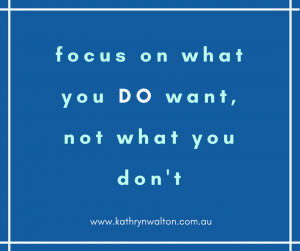


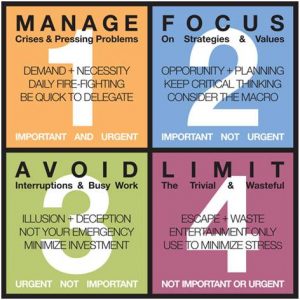
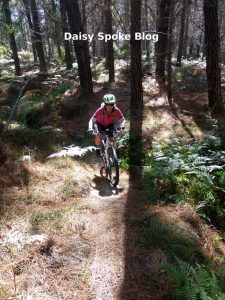 was missing it.
was missing it.  I’ve been practising and teaching this technique for a lot of years, and yet still I sometimes forget to do it when the moment arises. The thing is that on Sunday morning I DID NOTICE those fearful thoughts bouncing round my head. And guess what?
I’ve been practising and teaching this technique for a lot of years, and yet still I sometimes forget to do it when the moment arises. The thing is that on Sunday morning I DID NOTICE those fearful thoughts bouncing round my head. And guess what? 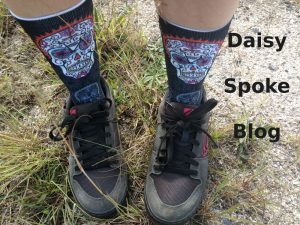 of short hills engaging my quads in an exertion that a couple of years ago would have been painful (if not impossible)! I pedalled in a higher gear than normal and found it easier than expected.
of short hills engaging my quads in an exertion that a couple of years ago would have been painful (if not impossible)! I pedalled in a higher gear than normal and found it easier than expected. 

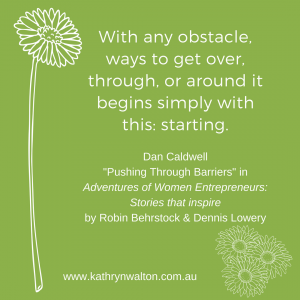


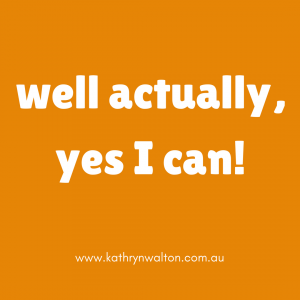
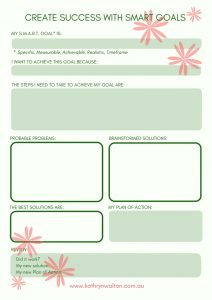

 further afield to step into our beautiful Australian bush country! As I’ve traversed the trail over the past few months, I’ve sometimes stopped to look at the rock garden and visualise myself riding through the narrow gaps between the rocks without clunking my pedals. I knew that I would need to develop a lot more skill, line accuracy, confidence and power to ride this section. Basically I’d been riding it so slowly that I didn’t have enough power to get over the craggy rocks. Although I enjoyed my brief little fantasies of riding effortlessly over and around the rocks, I certainly didn’t have much hope that I’d ever actually be able to do it.
further afield to step into our beautiful Australian bush country! As I’ve traversed the trail over the past few months, I’ve sometimes stopped to look at the rock garden and visualise myself riding through the narrow gaps between the rocks without clunking my pedals. I knew that I would need to develop a lot more skill, line accuracy, confidence and power to ride this section. Basically I’d been riding it so slowly that I didn’t have enough power to get over the craggy rocks. Although I enjoyed my brief little fantasies of riding effortlessly over and around the rocks, I certainly didn’t have much hope that I’d ever actually be able to do it.  about something that was upsetting me. I wasn’t very mindful of where I was or what I was doing. Suddenly I realised I’d already ridden through the rock garden! I hadn’t dabbed my foot, I didn’t jab my pedals, and the smooth flowy feeling hit the pit of my stomach and came out of my mouth with a loud shriek, my previous upset forgotten in a moment of elation as I realised what I’d done. I’d accidentally got it right!
about something that was upsetting me. I wasn’t very mindful of where I was or what I was doing. Suddenly I realised I’d already ridden through the rock garden! I hadn’t dabbed my foot, I didn’t jab my pedals, and the smooth flowy feeling hit the pit of my stomach and came out of my mouth with a loud shriek, my previous upset forgotten in a moment of elation as I realised what I’d done. I’d accidentally got it right! Today as I walk the same trail and peer along the rock garden, I can clearly see the line that I need to take on my bike. The rocks seem so much smaller than before, the gaps between them seem so much wider, and I realise just how powerful the images and thoughts in our minds can be.
Today as I walk the same trail and peer along the rock garden, I can clearly see the line that I need to take on my bike. The rocks seem so much smaller than before, the gaps between them seem so much wider, and I realise just how powerful the images and thoughts in our minds can be. Kathryn Walton shares information and reflections in Daisy Spoke that connect, inspire and self-empower women to make healthy choices for themselves.
Kathryn Walton shares information and reflections in Daisy Spoke that connect, inspire and self-empower women to make healthy choices for themselves.


 After much soul searching, I made the commitment to myself that I was going to conquer the fear that had irrationally built up in my mind. I really wanted to take charge of my fearful thoughts which seemed to be controlling my actions. It was as if my own thoughts were bullying me. The longer it went on, the worse it became. I knew that if I could get this sorted, I’d be able to transfer the skills and processes to other situations that make me nervous and better manage them as well.
After much soul searching, I made the commitment to myself that I was going to conquer the fear that had irrationally built up in my mind. I really wanted to take charge of my fearful thoughts which seemed to be controlling my actions. It was as if my own thoughts were bullying me. The longer it went on, the worse it became. I knew that if I could get this sorted, I’d be able to transfer the skills and processes to other situations that make me nervous and better manage them as well.
